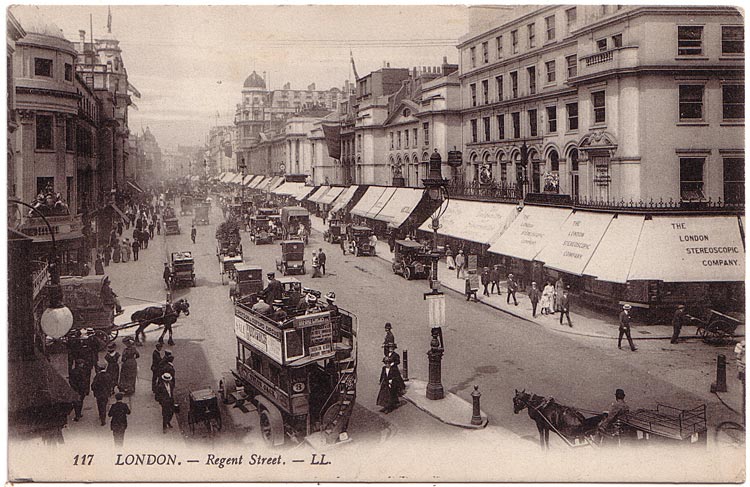Some time in 1854, at 313 Oxford Street, the “London Stereoscope Company” was born, and under the leadership of Managing Partner George Swan Nottage, by 1856 the company had changed its name, to “The London Stereoscopic Company”, and finally in May 1859 assumed the name it was to retain for years to come: the “London Stereoscopic and Photographic Company”.
Their business was selling stereo views and viewers to the public, and they were leaders in a boom – a craze – which swept England, Europe, and eventually the United States too, of stereo photographs of every conceivable subject, which, viewed by means of a stereoscope, presented scenes in life-like three dimensions. In a world which had never experienced television, film or the Internet, this was understandably a revelation. In February 1856, the London Stereoscopic Company (LSC) advertised, in the Photographic Journal, “The largest collection in Europe, upwards of 10,000” stereo views.
Although the fad faded in the 1860s, the company continued to operate and was, according to Getty Images, “one of the largest and most diverse businesses, with a global network of offices and staff photographers, selling and licensing images, cameras, equipment, papers and plates”. It does not seem to have been a major player in the second stereoscope boom at the turn of the twentieth century, however, and went out of business in 1922.
Recently revived by Queen legend Brian May, the new management are seeking to recreate the magic of the company, and hope that one day the London Stereoscopic Company will publish stereo cards once more. Brian was at the London Book Fair this week, and gave a press conference about his intriguing 3D publishing concept, revealing plans for new projects, including a 3-D Queen project.
“It’s hard to explain in a couple of minutes, but basically stereoscopy is with us in our lives every day,” he said. “We have just forgotten how the Victorians did it. The Victorians did it best and this is a recreation – this is my own recreation of a Victorian stereoscope. It’s 3-D. It’s like you saw Avatar in the movies, except this is the more perfect version of it. And what The London Stereoscopic Company is doing – this is the company that I’ve recreated from from the 1850s, is we’re publishing various kinds of 3-D books. The books are all illustrated with perfectly reproduced cards and with every book comes one of these ‘OWL’ stereoscopes. So you can experience Victorian stereoscopy exactly as the Victorians did, and they got very excited about it. And I find people get very excited about it right now.
“So many subjects – some from Victorian times like “Scenes in our Village” and the fabulous “Diableries”, which is devils from the 1860s, but I’m publishing now – we are publishing – books on Astronomy, modern-day Astronomy, but going way back to the 1850s as well.
We also have a “Queen In 3-D” book coming out, because I carried a 3-D camera with me the whole time we were on tour all those years. So I have lots of nice pictures of Freddie [Mercury] offstage and on, and the rest of us, John, Roger and myself, and we’re also going to bring it up to the present-day, so we’ll have pictures of the last tour we did a couple of months ago with Adam Lambert, so it’ll be a stereoscopic tour from the inside of Queen.”
• You can read a full transcript of his press conference here
• The company’s official web site – londonstereo.com – offers a huge number of images taken by the company’s Victorian photographers, including to a gallery of the entire series of T. R. Williams‘ most famous oeuvre, “Scenes in Our Village”.
The founder of downthetubes, which he established in 1998. John works as a comics and magazine editor, writer, and on promotional work for the Lakes International Comic Art Festival. He is currently editor of Star Trek Explorer, published by Titan – his third tour of duty on the title originally titled Star Trek Magazine.
Working in British comics publishing since the 1980s, his credits include editor of titles such as Doctor Who Magazine, Babylon 5 Magazine, and more. He also edited the comics anthology STRIP Magazine and edited several audio comics for ROK Comics. He has also edited several comic collections, including volumes of “Charley’s War” and “Dan Dare”.
He’s the writer of “Pilgrim: Secrets and Lies” for B7 Comics; “Crucible”, a creator-owned project with 2000AD artist Smuzz; and “Death Duty” and “Skow Dogs” with Dave Hailwood.
Categories: Art and Illustration, Books, Other Worlds

 Telos Publishing opens orders for The Fantastic Art of Ron Turner
Telos Publishing opens orders for The Fantastic Art of Ron Turner  Prince Valiant Artists illustrators Special #19 Limited Edition announced
Prince Valiant Artists illustrators Special #19 Limited Edition announced  Andrew Skilleter’s new art book, Illuminart 3, spotlights more of his Doctor Who art
Andrew Skilleter’s new art book, Illuminart 3, spotlights more of his Doctor Who art  In Memoriam: Comic Artist and illustrator Andrew Chiu
In Memoriam: Comic Artist and illustrator Andrew Chiu